信号分析与处理仿真实验
- 格式:docx
- 大小:669.00 KB
- 文档页数:12
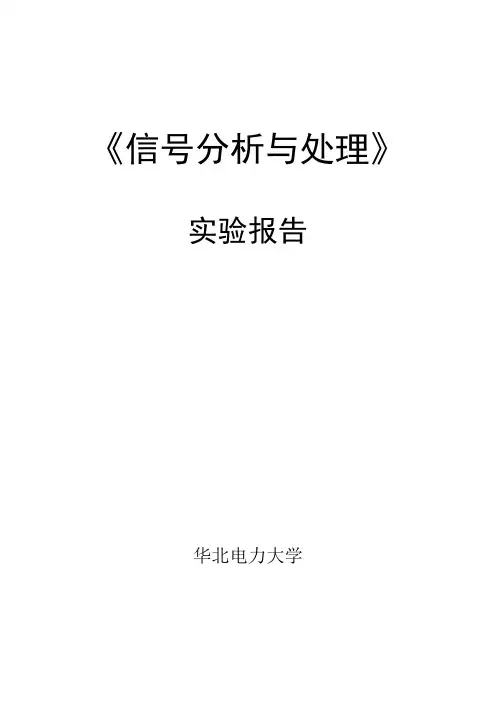
《信号分析与处理》实验报告华北电力大学前言1.实验总体目标通过实验,巩固掌握课程的讲授内容,使学生对信号分析与线性系统分析的基本理论及分析方法有一个感性认识和更好地理解,使学生在分析问题与解决问题的能力及实践技能方面有所提高。
2.适用专业自动化专业本科生3.先修课程信号分析与处理4.实验课时分配5需要配置微机及MATLAB工具软件。
6.实验总体要求1、掌握信号分解的基本思想及信号在时域、频域和变换域进行分解的基本理论及描述方法,用MATLAB编程语言实现基本信号的表示及可视化,计算和分析信号的频谱;2、掌握在时域、频域和变换域分析LTI系统的方法,及系统在时域、频域和变换域的描述方法,用MATLAB编程语言实现LTI系统的时域分析及频率分析。
3、掌握信号的调制与解调,用MATLAB编程语言仿真分析信号的调制与解调。
⒎ 本实验的重点、难点及教学方法建议实验通过MATLAB编程语言来实现基本信号的表示及可视化,计算分析信号的频谱,实现LTI系统的时域分析及频率分析,并仿真分析信号的调制与解调,使学生对信号分析与线性系统分析的基本理论及分析方法有一个感性认识和更好地理解。
实验的重点及难点是:掌握基本信号的数学表示,信号的频谱特点,计算LTI系统的典型响应,掌握信号的调制与解调。
在这样的理论基础上,学会用MATLAB编程语言来实现对信号与系统响应的可视化及对数字滤波器进行设计。
教学建议:打好理论基础,熟练编程语言。
目录实验一信号的时域与频域分析 3实验二信号的时域与频域处理 4实验三数字滤波器的设计 5实验一一、实验目的1、熟悉MATLAB 平台,高效的数值计算及符号计算功能;2、实现基本信号的表示及可视化计算;3、分析信号的频谱。
二、 实验类型验证型 三、 实验仪器微机,MATLAB 工具软件。
四、 实验原理MATLAB 是功能强大的数学软件,它提供了计算周期连续函数和周期离散序列的频谱的一系列函数。
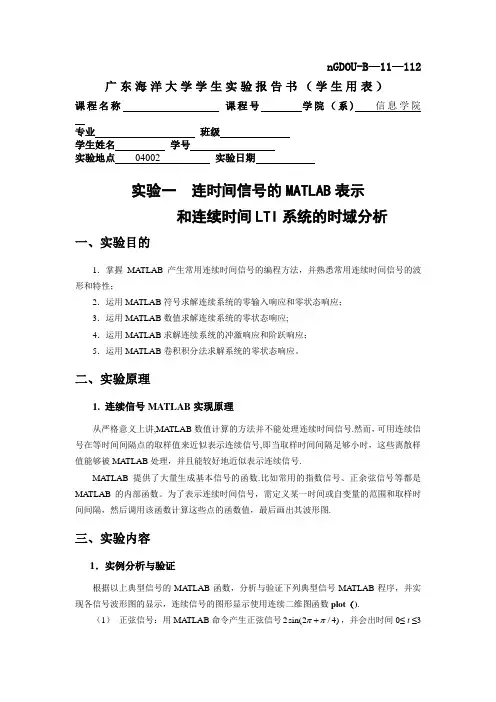
nGDOU-B—11—112广东海洋大学学生实验报告书(学生用表)课程名称课程号学院(系)信息学院专业班级学生姓名学号实验地点04002 实验日期实验一连时间信号的MATLAB表示和连续时间LTI系统的时域分析一、实验目的1.掌握MA TLAB产生常用连续时间信号的编程方法,并熟悉常用连续时间信号的波形和特性;2.运用MATLAB符号求解连续系统的零输入响应和零状态响应;3.运用MATLAB数值求解连续系统的零状态响应;4.运用MATLAB求解连续系统的冲激响应和阶跃响应;5.运用MATLAB卷积积分法求解系统的零状态响应。
二、实验原理1. 连续信号MATLAB实现原理从严格意义上讲,MA TLAB数值计算的方法并不能处理连续时间信号.然而,可用连续信号在等时间间隔点的取样值来近似表示连续信号,即当取样时间间隔足够小时,这些离散样值能够被MATLAB处理,并且能较好地近似表示连续信号.MATLAB提供了大量生成基本信号的函数.比如常用的指数信号、正余弦信号等都是MATLAB的内部函数。
为了表示连续时间信号,需定义某一时间或自变量的范围和取样时间间隔,然后调用该函数计算这些点的函数值,最后画出其波形图.三、实验内容1.实例分析与验证根据以上典型信号的MA TLAB函数,分析与验证下列典型信号MA TLAB程序,并实现各信号波形图的显示,连续信号的图形显示使用连续二维图函数plot().(1)正弦信号:用MA TLAB命令产生正弦信号2sin(2/4)ππ+,并会出时间0≤t≤3的波形图。
程序如下:K=2;w=2*pi ;phi=pi/4;t=0:0.01:3;ft=K*sin (w*t+phi );plot(t,ft ),grid on ;axis ([0,3,-2。
2,2.2])title (’正弦信号’)(2) 抽样信号:用MA TLAB 中的sinc(t)函数命令产生抽样信号Sa(t),并会出时间为66t ππ-≤≤的波形图。
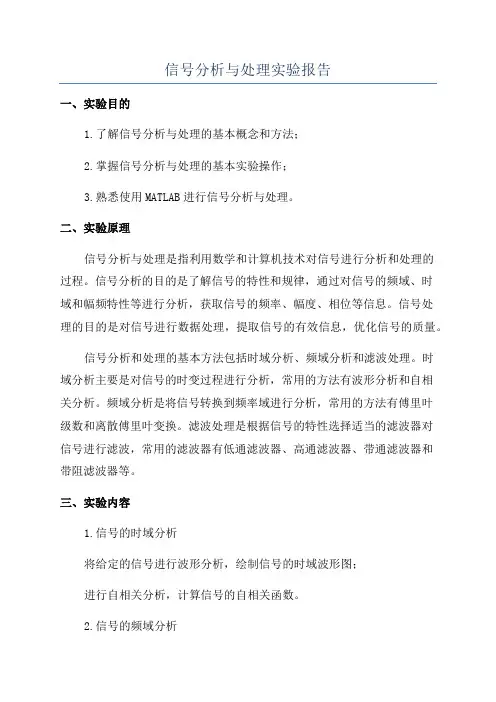
信号分析与处理实验报告一、实验目的1.了解信号分析与处理的基本概念和方法;2.掌握信号分析与处理的基本实验操作;3.熟悉使用MATLAB进行信号分析与处理。
二、实验原理信号分析与处理是指利用数学和计算机技术对信号进行分析和处理的过程。
信号分析的目的是了解信号的特性和规律,通过对信号的频域、时域和幅频特性等进行分析,获取信号的频率、幅度、相位等信息。
信号处理的目的是对信号进行数据处理,提取信号的有效信息,优化信号的质量。
信号分析和处理的基本方法包括时域分析、频域分析和滤波处理。
时域分析主要是对信号的时变过程进行分析,常用的方法有波形分析和自相关分析。
频域分析是将信号转换到频率域进行分析,常用的方法有傅里叶级数和离散傅里叶变换。
滤波处理是根据信号的特性选择适当的滤波器对信号进行滤波,常用的滤波器有低通滤波器、高通滤波器、带通滤波器和带阻滤波器等。
三、实验内容1.信号的时域分析将给定的信号进行波形分析,绘制信号的时域波形图;进行自相关分析,计算信号的自相关函数。
2.信号的频域分析使用傅里叶级数将信号转换到频域,绘制信号的频域图谱;使用离散傅里叶变换将信号转换到频域,绘制信号的频域图谱。
3.滤波处理选择合适的滤波器对信号进行滤波处理,观察滤波前后的信号波形和频谱。
四、实验步骤与数据1.时域分析选择一个信号进行时域分析,记录信号的波形和自相关函数。
2.频域分析选择一个信号进行傅里叶级数分析,记录信号的频谱;选择一个信号进行离散傅里叶变换分析,记录信号的频谱。
3.滤波处理选择一个信号,设计适当的滤波器对信号进行滤波处理,记录滤波前后的信号波形和频谱。
五、实验结果分析根据实验数据绘制的图像进行分析,对比不同信号在时域和频域上的特点。
观察滤波前后信号波形和频谱的变化,分析滤波效果的好坏。
分析不同滤波器对信号的影响,总结滤波处理的原理和方法。
六、实验总结通过本次实验,我们了解了信号分析与处理的基本概念和方法,掌握了信号分析与处理的基本实验操作,熟悉了使用MATLAB进行信号分析与处理。
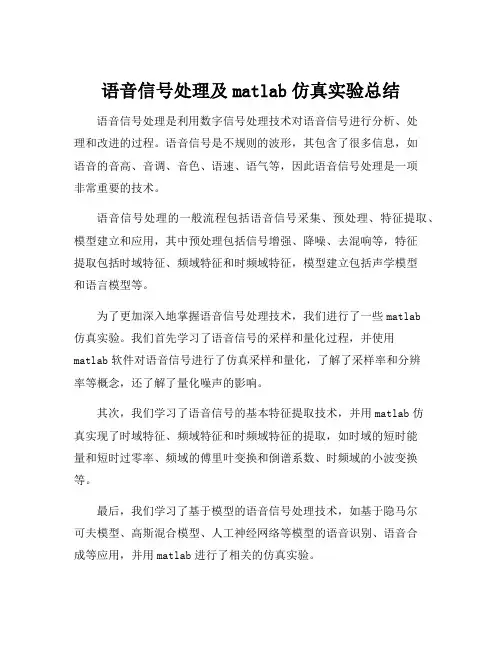
语音信号处理及matlab仿真实验总结
语音信号处理是利用数字信号处理技术对语音信号进行分析、处
理和改进的过程。
语音信号是不规则的波形,其包含了很多信息,如
语音的音高、音调、音色、语速、语气等,因此语音信号处理是一项
非常重要的技术。
语音信号处理的一般流程包括语音信号采集、预处理、特征提取、模型建立和应用,其中预处理包括信号增强、降噪、去混响等,特征
提取包括时域特征、频域特征和时频域特征,模型建立包括声学模型
和语言模型等。
为了更加深入地掌握语音信号处理技术,我们进行了一些matlab
仿真实验。
我们首先学习了语音信号的采样和量化过程,并使用
matlab软件对语音信号进行了仿真采样和量化,了解了采样率和分辨
率等概念,还了解了量化噪声的影响。
其次,我们学习了语音信号的基本特征提取技术,并用matlab仿
真实现了时域特征、频域特征和时频域特征的提取,如时域的短时能
量和短时过零率、频域的傅里叶变换和倒谱系数、时频域的小波变换等。
最后,我们学习了基于模型的语音信号处理技术,如基于隐马尔
可夫模型、高斯混合模型、人工神经网络等模型的语音识别、语音合
成等应用,并用matlab进行了相关的仿真实验。
总之,语音信号处理是一项非常重要的技术,它可以在语音识别、语音合成、语音压缩、语音增强等领域得到广泛应用。
通过学习语音
信号处理及matlab仿真实验,我们了解到了它的基本理论和应用方法,并得到了一些实践经验,这对我们今后的学习和工作将具有很大的指
导意义。
![Simulink 应用于信号的分析与处理_信号与系统实验教程(第二版)_[共3页]](https://uimg.taocdn.com/63225451bceb19e8b9f6bac9.webp)
·160· 和User-defined 差别不大,可以认为Time 是User-defined 的一个模板。
这里为了设置更多属性而选择User-defined 。
Frequency 主要用于显示频谱,当设置为Frequency 时,Vector Scope 只能显示一个frame ,如果有多个frame 输入,则显示最后一个。
运行仿真后,再双击Vector Scope 模块即可观察仿真结果,如图11-13所示。
注:一般在Vector Scope 模块中选择菜单Channels →Style →-以及Channels →Marker →Stem ,观察离散信号的效果会比较好。
图11-12 Vector Scope 模块的参数设置 图11-13 例11-2的仿真结果波形图 11.2 Simulink 应用于信号的分析与处理信号与系统中经常会涉及对信号的分析和处理,例如对两个信号进行卷积、分析信号的频域特性等。
Simulink 中的Signal Processing Blockset 中包含了许多信号处理相关的模块,如卷积、快速傅里叶变换、滤波器等,将这些模块灵活组合就能够实现很多信号处理系统。
与通过MATLAB 语言编程实现相比,在Simulink 中建模更直观,系统的流程更清晰,更容易分析信号的流向。
例11-3(参见第12章MATLAB 实验内容实验二、2.a ):设某LTI 系统的05[]0n n h n ⎧=⎨⎩≤≤其余,输入信号为105[]0n x n ⎧=⎨⎩≤≤其余, a .求输出y 1[n ] = x [n ] * h [n ]。
完成后的Simulink 模型如图11-14所示。
子系统h [n ]的内部构造如图11-15所示。
图11-14 例11-3的Simulink 模型图 图11-15 h [n ]的内部构造图。
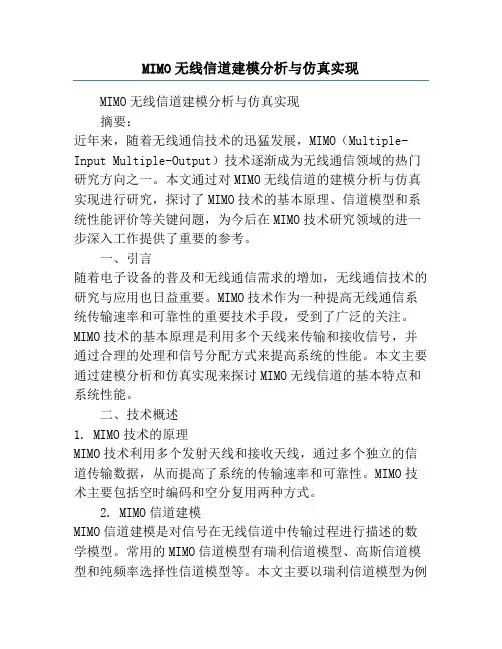
MIMO无线信道建模分析与仿真实现MIMO无线信道建模分析与仿真实现摘要:近年来,随着无线通信技术的迅猛发展,MIMO(Multiple-Input Multiple-Output)技术逐渐成为无线通信领域的热门研究方向之一。
本文通过对MIMO无线信道的建模分析与仿真实现进行研究,探讨了MIMO技术的基本原理、信道模型和系统性能评价等关键问题,为今后在MIMO技术研究领域的进一步深入工作提供了重要的参考。
一、引言随着电子设备的普及和无线通信需求的增加,无线通信技术的研究与应用也日益重要。
MIMO技术作为一种提高无线通信系统传输速率和可靠性的重要技术手段,受到了广泛的关注。
MIMO技术的基本原理是利用多个天线来传输和接收信号,并通过合理的处理和信号分配方式来提高系统的性能。
本文主要通过建模分析和仿真实现来探讨MIMO无线信道的基本特点和系统性能。
二、技术概述1. MIMO技术的原理MIMO技术利用多个发射天线和接收天线,通过多个独立的信道传输数据,从而提高了系统的传输速率和可靠性。
MIMO技术主要包括空时编码和空分复用两种方式。
2. MIMO信道建模MIMO信道建模是对信号在无线信道中传输过程进行描述的数学模型。
常用的MIMO信道模型有瑞利信道模型、高斯信道模型和纯频率选择性信道模型等。
本文主要以瑞利信道模型为例进行分析和仿真。
三、MIMO无线信道的建模分析1. 瑞利信道模型介绍瑞利信道模型是一种广义的无线信道模型,能够较好地描述实际无线信道中的多径效应。
瑞利信道模型的特点是具有时变性、时延离散性和频谱选择性。
2. 瑞利信道模型的数学描述瑞利信道模型可以通过复信道增益矩阵和复高斯白噪声进行描述。
复信道增益矩阵是一个矩阵,每个元素代表了信号在不同天线之间的传输增益;复高斯白噪声模拟了信道中的噪声干扰。
3. MIMO信道容量分析MIMO信道容量是衡量MIMO系统传输速率的重要指标。
通过对瑞利信道模型进行分析,可以得到MIMO信道的容量公式,并测量系统的信道容量。
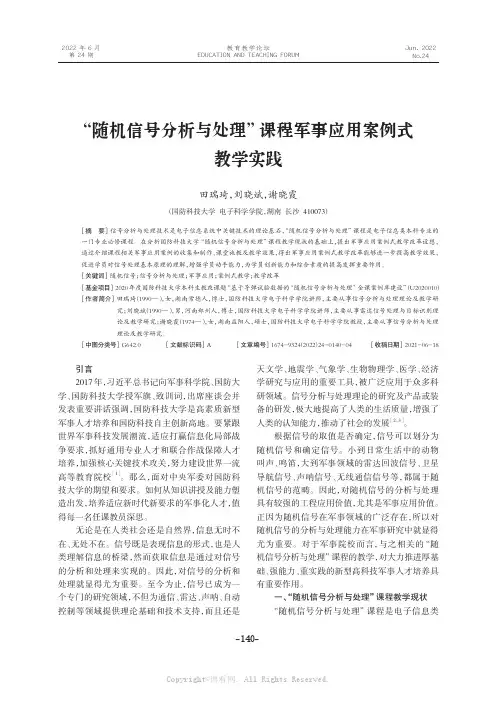
2022年6月第24期Jun. 2022No.24教育教学论坛EDUCATION AND TEACHING FORUM“随机信号分析与处理”课程军事应用案例式教学实践田瑞琦,刘晓斌,谢晓霞(国防科技大学 电子科学学院,湖南 长沙 410073)[摘 要] 信号分析与处理技术是电子信息系统中关键技术的理论基石,“随机信号分析与处理”课程是电子信息类本科专业的一门专业必修课程。
在分析国防科技大学“随机信号分析与处理”课程教学现状的基础上,提出军事应用案例式教学改革设想,通过介绍课程相关军事应用案例的收集和制作、课堂施教及教学效果,得出军事应用案例式教学改革能够进一步提高教学效果,促进学员对信号处理基本原理的理解,增强学员动手能力,为学员创新能力和综合素质的提高发挥重要作用。
[关键词] 随机信号;信号分析与处理;军事应用;案例式教学;教学改革[基金项目] 2020年度国防科技大学本科生教改课题“基于导弹试验数据的‘随机信号分析与处理’金课案例库建设”(U2020010)[作者简介] 田瑞琦(1990—),女,湖南常德人,博士,国防科技大学电子科学学院讲师,主要从事信号分析与处理理论及教学研究;刘晓斌(1990—),男,河南郑州人,博士,国防科技大学电子科学学院讲师,主要从事雷达信号处理与目标识别理论及教学研究;谢晓霞(1974—),女,湖南益阳人,硕士,国防科技大学电子科学学院教授,主要从事信号分析与处理理论及教学研究。
[中图分类号] G642.0 [文献标识码] A [文章编号] 1674-9324(2022)24-0140-04 [收稿日期] 2021-06-18引言2017年,习近平总书记向军事科学院、国防大学、国防科技大学授军旗、致训词,出席座谈会并发表重要讲话强调,国防科技大学是高素质新型军事人才培养和国防科技自主创新高地。
要紧跟世界军事科技发展潮流,适应打赢信息化局部战争要求,抓好通用专业人才和联合作战保障人才培养,加强核心关键技术攻关,努力建设世界一流高等教育院校[1]。
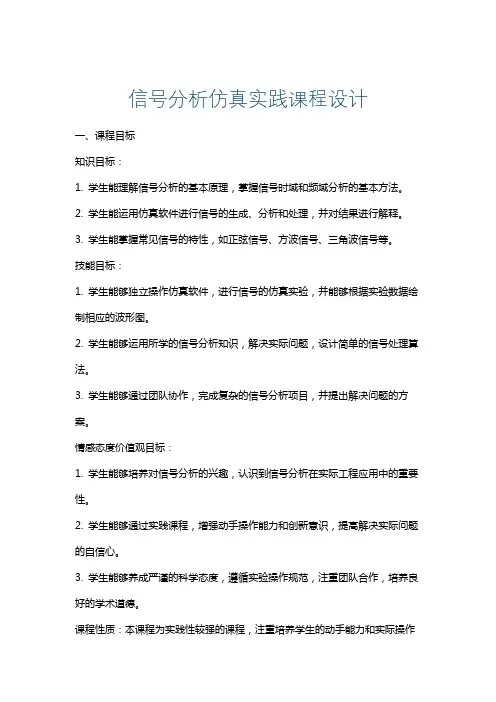
信号分析仿真实践课程设计一、课程目标知识目标:1. 学生能理解信号分析的基本原理,掌握信号时域和频域分析的基本方法。
2. 学生能运用仿真软件进行信号的生成、分析和处理,并对结果进行解释。
3. 学生能掌握常见信号的特性,如正弦信号、方波信号、三角波信号等。
技能目标:1. 学生能够独立操作仿真软件,进行信号的仿真实验,并能够根据实验数据绘制相应的波形图。
2. 学生能够运用所学的信号分析知识,解决实际问题,设计简单的信号处理算法。
3. 学生能够通过团队协作,完成复杂的信号分析项目,并提出解决问题的方案。
情感态度价值观目标:1. 学生能够培养对信号分析的兴趣,认识到信号分析在实际工程应用中的重要性。
2. 学生能够通过实践课程,增强动手操作能力和创新意识,提高解决实际问题的自信心。
3. 学生能够养成严谨的科学态度,遵循实验操作规范,注重团队合作,培养良好的学术道德。
课程性质:本课程为实践性较强的课程,注重培养学生的动手能力和实际操作技能。
学生特点:学生具备一定的信号与系统基础知识,对信号分析有一定了解,但对仿真软件操作和实际应用尚不熟悉。
教学要求:结合学生特点,采用“理论教学+实践操作”的方式进行,强调理论与实践相结合,注重培养学生的实际操作能力和问题解决能力。
通过课程学习,使学生在掌握基本理论知识的基础上,能够独立完成信号分析仿真实验,并具备一定的实际问题解决能力。
二、教学内容1. 信号与系统基础知识回顾:包括信号分类、信号的数学表示、系统的概念和分类。
- 教材章节:第一章 信号与系统基本概念2. 信号时域分析:介绍信号的时域特征,如幅值、周期、相位等,以及信号的时域运算。
- 教材章节:第二章 信号的时域分析3. 信号频域分析:讲解信号的频谱分析、傅里叶变换及其性质。
- 教材章节:第三章 信号的频域分析4. 仿真软件操作:学习使用MATLAB等仿真软件进行信号的生成、分析和处理。
- 教材章节:第四章 信号处理工具5. 实践项目一:信号生成与显示,如生成正弦波、方波等,并在时域和频域内进行显示和分析。
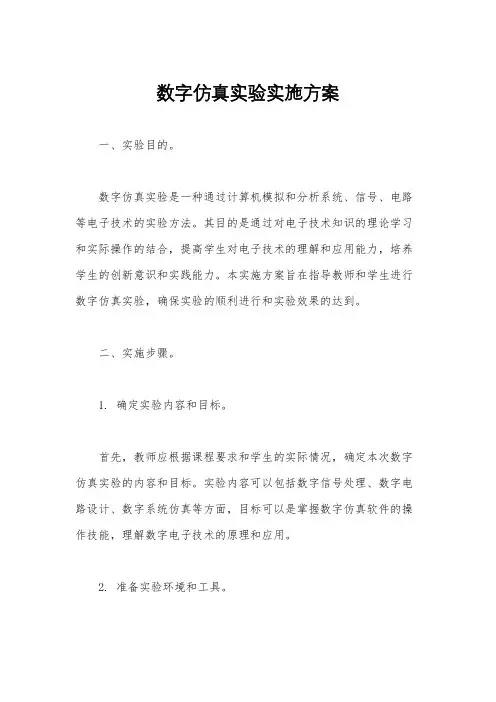
数字仿真实验实施方案一、实验目的。
数字仿真实验是一种通过计算机模拟和分析系统、信号、电路等电子技术的实验方法。
其目的是通过对电子技术知识的理论学习和实际操作的结合,提高学生对电子技术的理解和应用能力,培养学生的创新意识和实践能力。
本实施方案旨在指导教师和学生进行数字仿真实验,确保实验的顺利进行和实验效果的达到。
二、实施步骤。
1. 确定实验内容和目标。
首先,教师应根据课程要求和学生的实际情况,确定本次数字仿真实验的内容和目标。
实验内容可以包括数字信号处理、数字电路设计、数字系统仿真等方面,目标可以是掌握数字仿真软件的操作技能,理解数字电子技术的原理和应用。
2. 准备实验环境和工具。
在确定实验内容和目标后,教师需要准备好实验所需的计算机、数字仿真软件、实验指导书等工具和资料。
同时,要确保实验环境的安全和稳定,保证实验设备的正常运行。
3. 学生实验操作。
在实验进行时,教师应指导学生按照实验指导书的要求,正确操作数字仿真软件,进行实验内容的模拟和分析。
学生应认真对待实验,按照要求完成实验报告和实验数据的记录。
4. 实验结果分析和总结。
实验结束后,教师应指导学生对实验结果进行分析和总结,讨论实验中遇到的问题和解决方法,总结实验中的经验和教训。
同时,学生应根据实验结果撰写实验报告,展示实验过程和实验成果。
三、实施要求。
1. 教师应具备扎实的电子技术知识和丰富的实践经验,能够熟练操作数字仿真软件,指导学生进行实验操作。
2. 学生应具备一定的电子技术基础知识,能够独立操作计算机和数字仿真软件,完成实验内容和实验报告。
3. 实验环境应具备良好的计算机设备和网络条件,确保实验的顺利进行和实验数据的准确记录。
4. 实验过程中应严格遵守实验室规章制度,保证实验环境的安全和整洁。
四、实施效果评估。
为了确保数字仿真实验的效果和质量,教师应对实验过程和实验结果进行评估和检查。
评估内容可以包括学生的实验操作技能、实验报告的撰写质量、实验成果的达成情况等方面,及时发现问题并进行改进。

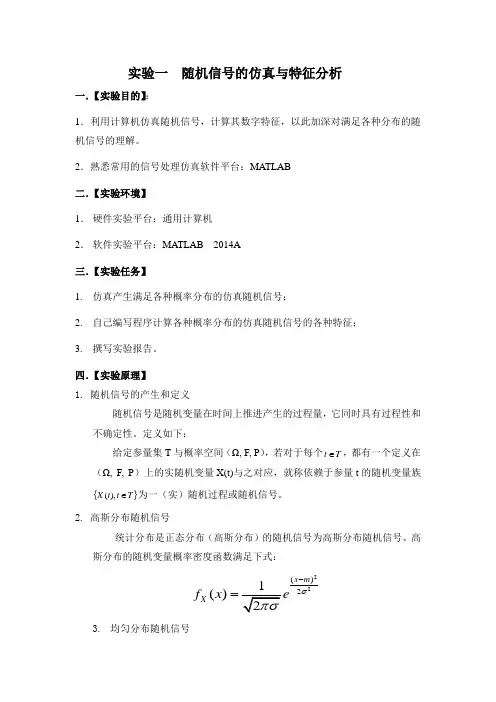
实验一随机信号的仿真与特征分析一.【实验目的】:1.利用计算机仿真随机信号,计算其数字特征,以此加深对满足各种分布的随机信号的理解。
2.熟悉常用的信号处理仿真软件平台:MATLAB二.【实验环境】1.硬件实验平台:通用计算机2.软件实验平台:MATLAB 2014A三.【实验任务】1.仿真产生满足各种概率分布的仿真随机信号;2.自己编写程序计算各种概率分布的仿真随机信号的各种特征;3.撰写实验报告。
四.【实验原理】1.随机信号的产生和定义随机信号是随机变量在时间上推进产生的过程量,它同时具有过程性和不确定性。
定义如下:给定参量集T与概率空间(Ω, F, P),若对于每个Tt∈,都有一个定义在(Ω, F, P)上的实随机变量X(t)与之对应,就称依赖于参量t的随机变量族{}TttX∈),(为一(实)随机过程或随机信号。
2.高斯分布随机信号统计分布是正态分布(高斯分布)的随机信号为高斯分布随机信号。
高斯分布的随机变量概率密度函数满足下式:22()21()x mXf x eσ-=3.均匀分布随机信号统计分布是均匀分布的随机信号为均匀分布随机信号。
均匀分布的随机变量概率密度函数满足下式:1(),X f x a x b b a=<<-4. 正弦随机信号给定具有某种概率分布的振幅随机变量A 、角频率随机变量Ω与相位随机变量Θ,(具体概率分布与特性视应用而定),以(时间)参量t 建立随机变量:)sin(),(Θ+Ω==t A s t W W t 。
于是,相应于某个参量域T 的随机变量族{}T t W t ∈,为正弦随机信号(或称为正弦随机过程)。
5. 贝努里随机信号贝努里随机变量X(s)基于一个掷币实验(s 表示基本结果事件):1表示s 为正面,0表示s 不为正面;s 不为正面的概率为P[X(s)=1]=p ,s 为正面的概率为P[X(s)=0]=q ,其中p+q=1。
若无休止地在t=n (n=0, 1, 2, …)时刻上,独立进行(相同的)掷币实验构成无限长的随机变量序列:,...}...,,,{,321n X X X X ,其中n X 与n 和s 都有关,应记为X(n,s),于是,⎩⎨⎧≠=====正面时刻,在正面时刻,在,,s n t s n t s n X X n 01),( 而且有概率:q s n X P p s n X P ====]0),([]1),([其中, p+q=1。
数字信号处理软件实验——MatLab仿真实验报告学院:电子工程学院班级:2013211202姓名:学号:实验一:数字信号的 FFT 分析1、实验内容及要求(1) 离散信号的频谱分析:设信号 此信号的0.3pi 和 0.302pi 两根谱线相距很近,谱线 0.45pi 的幅度很小,请选择合适的序列长度 N 和窗函数,用 DFT 分析其频谱,要求得到清楚的三根谱线。
(2) DTMF 信号频谱分析用计算机声卡采用一段通信系统中电话双音多频(DTMF )拨号数字 0~9的数据,采用快速傅立叶变换(FFT )分析这10个号码DTMF 拨号时的频谱。
2、实验目的通过本次实验,应该掌握:(a) 用傅立叶变换进行信号分析时基本参数的选择。
(b) 经过离散时间傅立叶变换(DTFT )和有限长度离散傅立叶变换(DFT ) 后信号频谱上的区别,前者 DTFT 时间域是离散信号,频率域还是连续的,而 DFT 在两个域中都是离散的。
(c) 离散傅立叶变换的基本原理、特性,以及经典的快速算法(基2时间抽选法),体会快速算法的效率。
(d) 获得一个高密度频谱和高分辨率频谱的概念和方法,建立频率分辨率和时间分辨率的概念,为将来进一步进行时频分析(例如小波)的学习和研究打下基础。
(e) 建立 DFT 从整体上可看成是由窄带相邻滤波器组成的滤波器组的概念,此概念的一个典型应用是数字音频压缩中的分析滤波器,例如 DVD AC3 和MPEG Audio 。
3.设计思路及实验步骤1)离散信号的频谱分析:该信号中要求能够清楚的观察到三根谱线。
由于频率0.3pi 和0.302pi 间隔非常小,要清楚的显示,必须采取足够大小的N ,使得分辨率足够好,至少到0.001单位级,而频率0.45pi 的幅度很小,要清楚的观察到它的谱线,必须采取幅度够大的窗函数,使得它的频谱幅度变大一些。
同时还要注意频谱泄漏的问题,三个正弦函数的周期(2pi/w )分别为20,40,1000,所以为了避免产生频谱泄漏(k=w/w0为整数),采样点数N 必须为1000的整数倍。
《信号与系统》MATLAB仿真实验讲义(第二版)肖尚辉编写宜宾学院电信系电子信息教研室《信号与系统》课程2004年3月 宜宾使用对象:电子专业02级3/4班(本科)实验一 产生信号波形的仿真实验一、实验目的:熟悉MATLAB软件的使用,并学会信号的表示和以及用MATLAB来产生信号并实现信号的可视化。
二、实验时数:3学时+3学时(即两次实验内容)三、实验内容:信号按照自变量的取值是否连续可分为连续时间信号和离散时间信号。
对信号进行时域分析,首先需要将信号随时间变化的规律用二维曲线表示出来。
对于简单信号可以通过手工绘制其波形,但对于复杂的信号,手工绘制信号波形显得十分困难,且难以绘制精确的曲线。
在MATLAB中通常用三种方法来产生并表示信号,即(1)用MATLAB软件的funtool符合计算方法(图示化函数计算器)来产生并表示信号;(2)用MATLAB软件的信号处理工具箱(Signal Processing Toolbox)来产生并表示信号;(3)用MATLAB软件的仿真工具箱Simulink中的信号源模块。
(一) 用MATLAB软件的funtool符合计算方法(图示化函数计算器)来产生并表示信号在MATLAB环境下输入指令funtool,则回产生三个视窗。
即figure No.1:可轮流激活,显示figure No.3的计算结果。
figure No.2:可轮流激活,显示figure No.3的计算结果。
figure No.3:函数运算器,其功能有:f,g可输入函数表达式;x是自变量,在缺省时在[-2pi,2pi]的范围内;自由参数是a;在分别输入完毕后,按下面四排的任一运算操作键,则可在figure No.1或figure No.2产生相应的波形。
学生实验内容:产生以下信号波形3sin(x)、5exp(-x)、sin(x)/x、1-2abs(x)/a、sqrt(a*x)(二) 用MATLAB软件的信号处理工具箱(Signal Processing Toolbox)来产生并表示信号一种是用向量来表示信号,另一种则是用符合运算的方法来表示信号。
《信号分析与处理》实验指导书(修订版)上海大学精密机械工程系2009年4月目录DRVI可重构虚拟仪器实验平台简介 (2)实验一常用数字信号生成实验 (8)实验二典型信号波形的合成与分解实验 (11)实验三滤波器原理与应用实验 (13)附录一151DRVI可重构虚拟仪器实验平台简介1、概述DRVI的主体为一个带软件控制线和数据线的软主板,其上可插接软仪表盘、软信号发生器、软信号处理电路、软波形显示芯片等软件芯片组,并能与A/D卡、I/O卡等信号采集硬件进行组合与连接。
直接在以软件总线为基础的面板上通过简单的可视化插/拔软件芯片和连线,就可以完成对仪器功能的裁减、重组和定制,快速搭建一个按应用需求定制的虚拟仪器测量系统。
图2、虚拟仪器软件总线结构图2、软件运行双击WINDOWS桌面上的图标,或在程序组中的DRVI,就可以启动DRVI 软件。
DRVI启动后点击红色箭头所示按钮从DRVI采集卡、运动控制卡,或网络在线进行注册登记,获取软件使用权限,然后就可以使用了。
图3、DRVI 软件运行界面3、插接软件芯片DRVI 通过在前面板上可视化插接虚拟仪器软件芯片来搭构虚拟仪器或测量实验。
插接软件芯片的过程很简单,从软件芯片表中点击需要的软件芯片,将其添加到DRVI 前面板上,然后在新插入的软件芯片上压下鼠标不放,将其拖动到合适位置。
重复上述步骤,插入其它软件芯片。
插接在DRVI 前面板上的虚拟仪器软件芯片的屏幕位置是可以移动和调整的,点击快捷工具条中的“移动软件芯片位置”图标,然后在待移动的软件芯片上压下鼠标不放,就可以将其拖动到新位置,从而实现屏幕布局的调整。
4、DRVI 软件总线的概念和软件芯片的连线图4 用DRVI 设计虚拟仪器为实现虚拟仪器软件芯片间的数据交换,DRVI中设置了一组软件总线,包括256条Double型单变量数据线和32条Double型数组型数据线,可传输有效值等单变量数据,也可传输波形、频谱等数组数据。
《信号与系统教程》教案信号与系统的MATLAB仿真信号与系统是电子信息类专业以及相关领域常见的一门重要课程,是学生建立系统性的信号与系统理论知识体系的基础课程。
在学习信号与系统的过程中,MATLAB仿真是一个非常重要的工具,通过仿真可以更直观地理解信号与系统的原理和性质,加深学生对课程内容的理解和掌握。
一、实验目的:1.掌握使用MATLAB进行信号与系统仿真的基本方法;2.熟练掌握MATLAB中信号处理和系统分析的基本函数;3.理解信号与系统的基本性质和特点;4.通过仿真实验加深对信号与系统理论的理解。
二、实验内容:1.基本信号的生成与显示通过MATLAB编程生成并显示几种基本信号,如冲激信号、阶跃信号、正弦信号等,并观察它们的波形和频谱特性。
2.离散信号的处理与显示利用MATLAB进行离散信号的加减运算、时域缩放和频域移位等操作,并观察信号在时域和频域上的变化。
3.模拟系统的搭建与分析通过MATLAB建立一个简单的模拟系统,如一阶低通滤波器或者二阶高通滤波器,然后仿真系统的频率响应和时域响应。
4.离散系统的搭建与分析以差分方程形式给出一个离散系统的描述,用MATLAB实现系统的差分方程求解,并分析系统的频率响应和稳定性。
三、实验步骤:1.编写MATLAB代码生成基本信号,并绘制信号波形和频谱图;2.对生成的基本信号进行加减运算、缩放和移位等处理,并观察处理后的信号波形和频谱;3.建立一个模拟系统的传递函数或状态空间方程,利用MATLAB进行系统的频率响应和时域响应仿真;4.建立一个离散系统的差分方程描述,用MATLAB求解系统的时域响应,并分析系统的频谱特性和稳定性;四、实验结果:1.完成了基本信号的生成和显示,能够准确地观察不同信号的时域波形和频谱特性;2.成功实现了对离散信号的处理和显示,掌握了信号的加减、缩放和移位方法;3.实现了一个模拟系统的频率响应和时域响应仿真,了解了系统的性能和特点;4.成功建立了一个离散系统的差分方程模型,通过MATLAB求解得到系统的时域响应,并对系统的频谱和稳定性进行了分析。
信号处理技术实验报告在信号处理技术这一领域里,实验是非常重要的一环。
本次实验旨在通过实操操作和数据分析,探讨信号处理技术的应用和原理。
以下将详细介绍实验过程和结果。
实验一:滤波器设计与实现在本实验中,我们首先学习了滤波器的设计原理,然后通过软件仿真工具进行了滤波器的设计与实现。
我们分别设计了低通滤波器、高通滤波器和带通滤波器,通过观察输出信号波形和频谱图,我们验证了设计的滤波器的有效性。
实验二:采样定理验证实验采样定理是信号处理技术中一个非常重要的理论。
在本实验中,我们进行了一系列的采样实验,验证采样频率是否满足信号的重构条件。
通过实验数据的对比分析,我们验证了采样定理的正确性,并且得出了一些结论和经验。
实验三:数字信号处理硬件实现本次实验中,我们使用FPGA芯片进行了数字信号的硬件实现。
我们编写了Verilog代码,实现了数字信号的低通滤波和加法运算。
通过实验数据的对比和波形分析,我们验证了硬件实现的正确性,并且对FPGA在信号处理中的应用有了更深入的理解。
实验四:信号处理算法优化在这个实验中,我们学习了常见的信号处理算法,比如快速傅里叶变换(FFT)和小波变换。
我们通过对算法的原理和实现细节进行分析,并尝试对算法进行优化。
通过实验数据的对比和性能测试,我们得出了一些优化算法的结论,为实际应用提供了指导。
总结:通过本次实验,我们深入了解了信号处理技术的基本原理和应用。
我们通过实操操作和数据分析,掌握了一定的实验技能,并且对信号处理技术有了更深入的认识。
希望在以后的学习和工作中能够更好地运用所学的知识,为信号处理技术的发展做出贡献。
实验报告
实验名称MATLAB仿真实验
课程名称信号分析与处理
院系部: 专业班级:学生姓名:学号:同组人:实验台号:指导教师:成绩:实验日期:2015-11-29
实验一信号的产生与运算
1.单位阶跃信号
(1)源程序
t=-0.5:0.01:1.5;
u=stepfun(t,0);
u1=stepfun(t,0.5);
figure(1)
plot(t,u);axis([-0.5 1.5 -0.2 1.2]);title('单位阶跃信号波形'); figure(2)
plot(t,u1);axis([-0.5 1.5 -0.2 1.2]);title('延迟单位阶跃信号波形'); (2)实验结果
2.单位冲激信号
(1)源程序
clear;clc;
t=-1:0.001:1;
for i=1:3
dt=1/(i^4);
x=(1/dt)*((t>=-(1/2*dt))-(t>=(1/2*dt))); subplot(1,3,i);
stairs(t,x);
end
(2)实验结果
3.抽样信号
(1)源程序
clear;clc;
t=-20:0.01:20;
x=sinc(t/pi);
plot(t,x); title('抽样信号'); (2)实验结果
4.单位样值序列(1)源程序
clear;clc;
n1=input('n1=');
n2=('n2=');
n=n1:n2;
k=length(n);
x1=zeros(1,k);
x1(1,-n1+1)=1 subplot(1,2,1); stem(n,x1,'filled')
(2)实验结果
信号运算的MATLAB实现
连续信号的运算
例9-1
(1)源程序
t=-3:0.01:3;
u=(t+1).*((t>-1)-(t>0))+(t>0)-(t>1);
figure(1)
plot(t,u);axis([-3 3 -0.2 1.2]);title('x(t)');
u2=(-t+1).*((-t>-1)-(-t>0))+(-t>0)-(-t>1);
figure(2)
plot(t,u2);axis([-3 3 -0.2 1.2]);title('x(-t)'); (2)实验结果
序列的运算
例9-4
(1)源程序
n=0:8;
x1=[1 0 2 4 3 -1 2 3 0];
subplot(2,2,1);
stem(n,x1,'filled');
axis([-1,9,-2,5]);title('x1(n)'); x2=[0 0 0 2 3 1 2 4 3];
subplot(2,2,2);
stem(n,x2,'filled');
axis([-1,9,-2,5]);
title('x2(n)');
x3=x1+x2;
subplot(2,2,3);
stem(n,x3,'filled');
axis([-1,9,-2,13]);
title('x1(n)+x2(n)');
(2)实验结果
实验二连续时间信号的分析
1.连续时间信号的复频域分析
用MATLAB求解信号的laplace变换与反变换
例9-11
(1)源程序
syms t a;
x1t=exp(-a*t);
x2t=cos(2*t);
x1s=laplace(x1t);
x2s=laplace(x2t);
(2)实验结果
>> x1s
x1s =
1/(s+a)
>> x2s
x2s =
s/(s^2+4)
例9-12
(1)源程序
syms s;
xs=s^2/(s^2+3*s+2);
xt=ilaplace(xs,s,t)
(2)实验结果
xt =
dirac(t)-4*exp(-2*t)+exp(-t)
2.连续时间信号的频域分析
用MATLAB求解非周期信号的傅里叶变换
例9-20
(1)源程序
syms s t w;
x=1/2*exp(-2*t)*sym('Heaviside(t)');
X=fourier(x)
subplot(1,2,1);ezplot(x)
subplot(1,2,2);ezplot(abs(X))
(2)实验结果
实验三离散时间信号的分析
1.离散时间信号的频谱分析
用matlab求解离散时间信号傅里叶变换
例9-23
(1)源程序
clc;clear;
n=-5:5;
x=(-0.9).^n;k=-200:200;
w=(pi/100)*k;
X=x*(exp(-j*pi/100)).^(n'*k);
magX=abs(X);
angX=angle(X);
subplot(2,1,1);plot(w/pi,magX);
axis([-2,2,0,15]);xlabel('\Omega/(\pi)');ylabel('幅度'); subplot(2,1,2);plot(w/pi,angX)/pi;
axis([-2,2,-4,4]);xlabel('\Omega/(\pi)');ylabel('相位/(\pi)'); (2)实验结果
X=(-0.9)^n,-5<=n<=5 的离散傅里叶变换
用FFT的结果分析模拟信号的频谱
例9-24
(1)源程序
clcl;clear;
t=0:0.02/64:0.04;
f1=50;
y1=cos(2*pi*f1*t)+0.5*cos(2*pi*3*f1*t)+0.3*cos(2*pi*5*f1*t); subplot(311);plot(t,y1);
t=0:0.02/16:0.02-0.02/16;
f=cos(2*pi*f1*t)+0.5*cos(2*pi*3*f1*t)+0.3*cos(2*pi*5*f1*t);
F_1024=2*abs(fft(f,16))/16;
k=0:1:15;
subplot(312);stem(k,abs(F_1024));
axis([0,16,0,1.5]);
F_1024=2*abs(fft(f,1024))/16;
L=0:1023;
subplot(313);plot(L/1023,abs(F_1024));
set(gca,'xtick',[0,0.0625,0.125,0.1875,0.25,0.3125,0.375,0.4375,0.5, 0.5625,0.625,0.6875,0.75,0.8125,0.875,0.9375,1]);
(2)实验结果
(a)信号的波形
(b)信号的离散频谱
(c)补零得到的连续频谱。